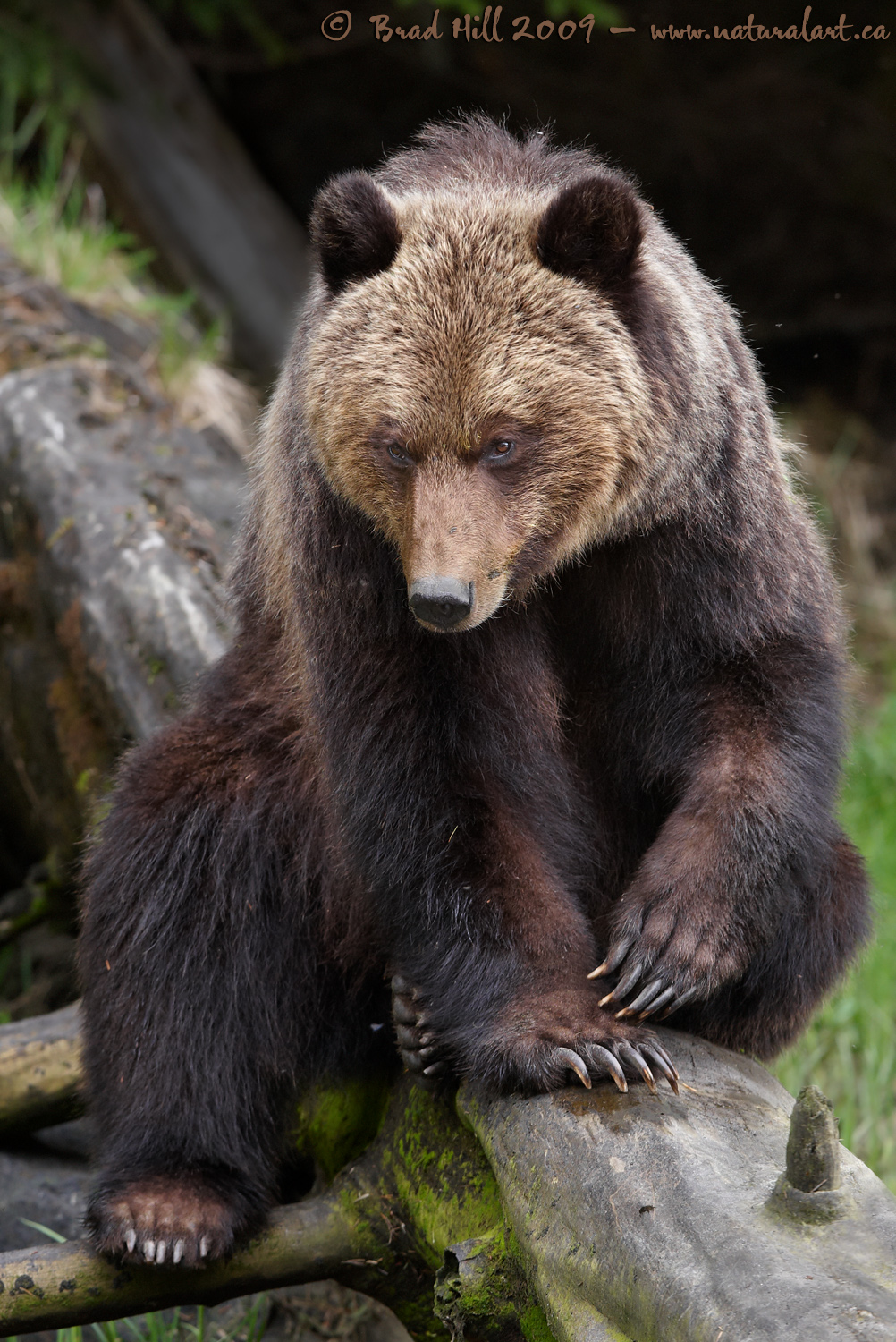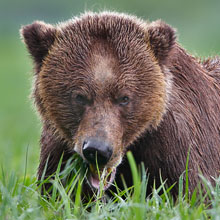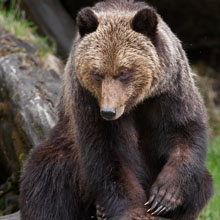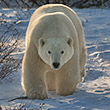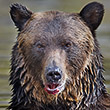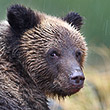Availability: Undetermined - Enquiries?
In the Field
Debating His Options... Khutzeymateen Inlet (Great Bear Rainforest), BC. May 28, 2009.
When I processed this image it struck me that this may be my only photo of a grizzly where all 4 paws and sets of claws are showing in the same image! So if you like claws - you might like this one. When I took this photo the bear had been, up until seconds before I shot it, very calm and relaxed. Then it looked past me and saw something that drew its attention in a major way. Turns out that it was another grizzly behind me (and I did thank my subject to alerting me to it!), only much bigger than this guy! At the time of shooting this bear looked (and probably was) debating his options. Seconds after I shot this he decided that discretion was a better option than valour (and he vamoosed)!
Over the last couple of years I've noticed an interesting trend in shooting styles (both of my clients and of other photographers). Perhaps it's because of the drop in price in high-capacity memory cards, but I've noticed far more "machine-gunning" than selective shooting in recent years. I'm the first to argue for the value of cameras with high frame rates and the value of "letting it rip" in certain situations (like for flight shots or sparring animals), but I'm questioning the value of it on static subjects. I tend to shoot very selectively - I rarely capture more than 15,000 to 20,000 shots in an entire YEAR (excluding shots where I'm testing new bits of gear). Yet I'm often in the field with folks who shoot this much in 3 or 4 days (the thought of culling/sorting all these images terrifies me!). Yet, I have seen cases where after all this shooting there are very few outstanding results in those thousands of images. While I don't think it's my place to suggest what others should do, for me it works far better to absolutely focus on what my subject is doing (and stick with it, and stick with it, and stick with it...well, you get the picture) and shoot much more selectively and carefully.
ADDITIONAL NOTES:
1. This image - in all resolutions - is protected by copyright. I'm fine with personal uses of them (including use as desktop backgrounds or screensavers on your own computer), but unauthorized commercial use of the image is prohibited by law. Thanks in advance for respecting my copyright!
2. This image was captured during one of my two spring "Grizzlies of the Khutzeymateen" photo tours in May/June of 2009. Each year I offer trips into two different parts of the Great Bear Rainforest as well as one to photograph aquatic mammals and oceanscapes near the northern tip of Vancouver Island. And, in selected years, I also offer photo tours to locations to capture other highly sought-after subjects, such as various boreal owl species and wildlife of Canada's Arctic. Details about these trips can be found on the Photo Tours page of this website.
3. Like all wildlife photographs on this website, this image was captured following the strict ethical guidelines described in The Wildlife FIRST! Principles of Photographer Conduct. I encourage all wildlife photographers to always put the welfare of their subjects above the value of their photographs.
Behind the Camera
Debating His Options... Khutzeymateen Inlet (Great Bear Rainforest), BC. May 28, 2009.
Digital Capture; Compressed RAW (NEF) 14-bit format; ISO 1600.
Nikon D700 with Nikon 200-400 mm f/4G ED-IF AF-S VR lens @ 300mm - hand-held from floating Zodiac. VR on and set to "Normal" mode.
1/250s @ f5.6; -0.33 stop compensation from matrix-metered exposure setting of camera.
At the Computer
Debating His Options... Khutzeymateen Inlet (Great Bear Rainforest), BC. May 28, 2009.
RAW Conversion to 16-bit TIFF, including first-pass/capture sharpening using Phase One's Capture One Pro 5. Three RAW conversions at different exposure and saturation settings. Exposure settings of -1.0 stops (to recover highlight detail and darken background) through to +0.25 stops (to recover shadow detail on the area on the top of the bear's forelegs).
Further digital corrections on 16-bit TIFF file using Adobe's Photoshop CS4 and Light Craft's LightZone. Photoshop adjustments included compositing and masking of 3 exposure versions, selective saturation and de-saturation of colours, and selective sharpening for web output. Final tonemapping, balancing and tweaking performed using the Tonemapper/Re-light tool in LightZone.
Conservation
Debating His Options... Khutzeymateen Inlet (Great Bear Rainforest), BC. May 28, 2009.
Ten percent of the revenue generated by this image will be donated to Raincoast*.
Species Status in Canada**: Special Concern (May 2002).
While Grizzly Bears (Ursus arctos) are not technically listed as "Endangered" in Canada, they have been extirpated from most of their historical range. Grizzly Bears are far more sensitive to intrusion/disturbance in their habitat than are Black Bears and are being increasingly forced into marginal habitat by human encroachment. The Great Bear Rainforest along the central and northern coast of British Columbia is one of the last strongholds of the Grizzly Bear in Canada, and even this population is coming under increasing pressure.
On December 18, 2017 the government of British Columbia banned grizzly hunting across the entire province. This major conservation victory came after decades of tireless work by many dedicated conservationists and ecologists and, most importantly, it reflects the opinion of the vast majority of British Columbians. And, it means that AT LEAST while the current government remains in power grizzlies are finally "safe" in British Columbia.
Now that we've at least temporarily won the battle to save grizzlies in BC, it's time to re-focus our efforts toward protecting ALL of BC's carnivores, including Gray Wolves, Black Bears, Cougars, Wolverines, and more! Simply put, there are no ecological, economic, or ethical arguments supporting the trophy hunting of carnivores.
In a great first step towards ending the hunting of carnivores throughout BC the Raincoast Conservation Foundation has developed a program designed to protect ALL carnivores within the Great Bear Rainforest. Details about this program can be found on this page on Raincoast's website. Check it out and, better yet, make a donation to help Raincoast purchase the remaining commercial hunting tenures in the Great Bear!
*The Raincoast Conservation Society (and Foundation) is an effective and efficient organization that has been fighting for protection of this unique habitat. If you are looking for a meaningful way to contribute to the conservation of this amazing ecosystem, Raincoast will provide maximal "bang" for your conservation dollars.
**as determined by COSEWIC: The Committee on the Status of Endangered Wildlife in Canada












